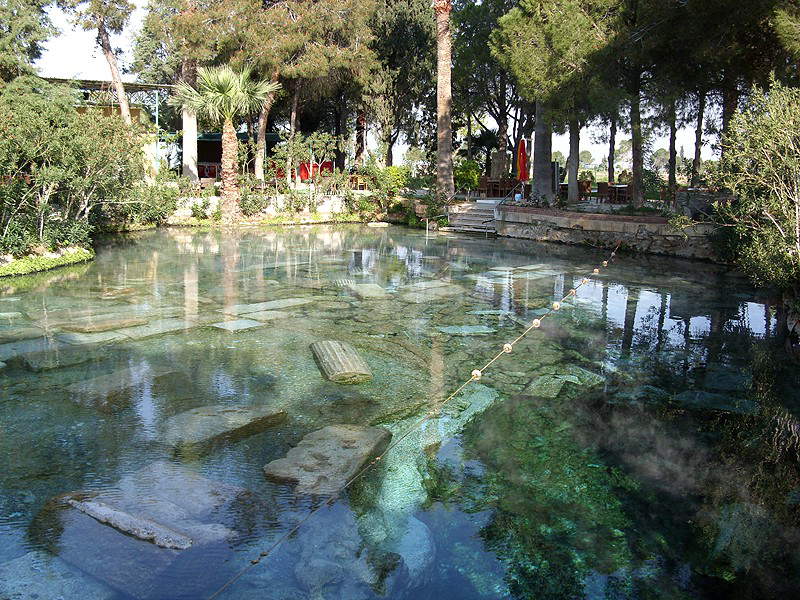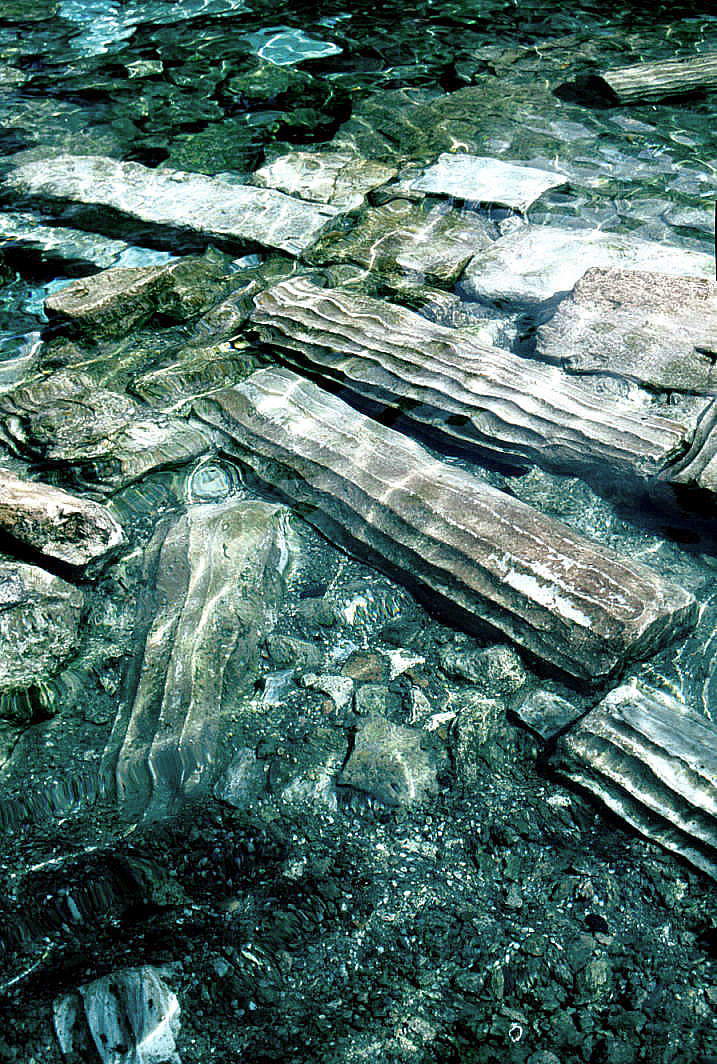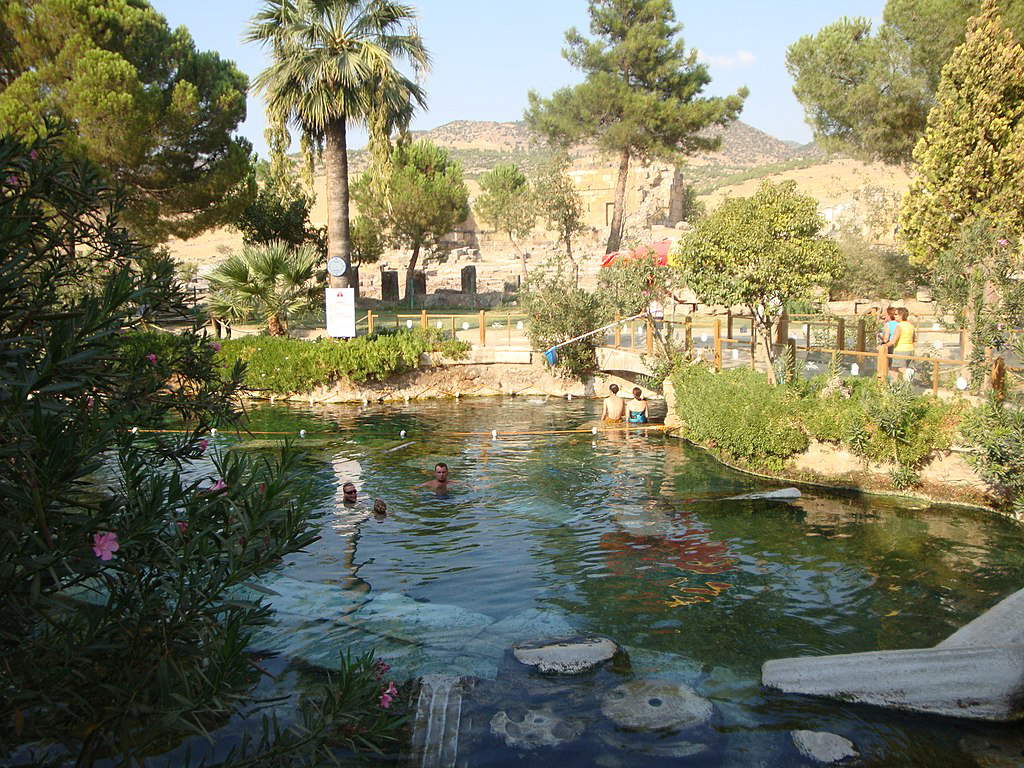Bathing inside one of the oldest hot springs in existence, exactly the way we bathed hundreds of years ago. We are in Turkey but we evokeEgypt and the Romans. Let’s talk about what is called by all the “Cleopatra’s Pool,” the pharaoh who in the height of her people’s splendor came to bathe in these waters renowned throughout antiquity for the treatment of skin diseases, benefited those who had circulation problems, rheumatism. Hot thermal waters, geothermal mineral water springing here at 36 degrees Celsius in that locality called at the time Hierapolis, which today is called Pammukale, about 20 kilometers from Denizli (in southwestern Turkey, in the Aegean region, in the valley of the Menderes River), in the territory of ancient Phrygia, where one immerses oneself among the ancient submerged ruins of the building that surrounded the pool at the time: ancient columns and archaeological remains deposited on the bottom, in a florilegium of tropical vegetation with palm trees and flowers. The sense of history combined with the well-being of this now world-famous UNESCO World Heritage tourist destination.
In fact, the archaeological site continues along a kilometer on which other ruins include those of the Temple of Apollo, and the large 10,000-seat theater arranged in 46 rows, dating from thetime of Severus, decorated with an admirable frieze depicting a ritual procession and sacrifice to Artemis of Ephesus. Well-preserved remains also remain of the necropolis located further north, which stretches over two kilometers and offers a vast panorama of Graeco-Roman funerary practices. Remains from the Greco-Roman period include baths, temple ruins, a monumental arch, and a nymphaeum.
Mark Antony spared no expense and built major thermal baths on the spring, and Cleopatra’s pool was framed by marble Ionic porticoes erected in the 2nd century B.C., which were later destroyed by earthquake tremors ending up inside the pool.
The UNESCO site to be exact is “Hierapolis-Pamukkale,” and it also includes the incredible white-colored rock and water formation that gives the place its name: in Turkish “Pamukkale” means “cotton castle.” But what might look like a fairy-tale white castle perched on a promontory with spires, tower terraces and lookout points is actually not the work of man but of Nature.




Plains of calcite, very white, forming pools side by side with water inside them warm and rich in minerals from the mountain above. Originating from springs in a nearly 200-meter-high cliff overlooking the plain, the calcite-laden waters have created an unreal landscape in Pamukkale of mineral forests, petrified waterfalls, and travertine pools. The site covers an area 2700 meters long and 160 meters high, and as recognized by UNESCO when it gave reasons for placing it under World Heritage protection, this is an “extraordinary landscape,” “visually stunning.” The mineralized waters, rich in calcium hydrocarbonate, which in contact with air results in the sedimentation of calcium carbonate, have generated a series of petrified waterfalls, stalactites and pools with stepped terraces, some of which are less than a meter high while others are up to six meters high. Fresh deposits of calcium carbonate give these formations such a dazzlingly white coating.
And with the nearby Hellenistic spa town of Hierapolis, founded by the Attalid kings of Pergamum in the late 2nd century B.C., it was beckoning for antiquity. Ceded to Rome in 2 BC, Hierapolis flourished, reaching the height of its importance in the 2nd and 3rd centuries AD, after being destroyed by an earthquake in 133 AD and rebuilt.
The combination of striking natural formations and the development of a complex system of canals, bringing thermal water to nearby villages and fields, is exceptional. The springs are the source of a hydraulic system that extends 70 km northwest of Alasehir and westward along the Menderes River valley.
The Hierapolis Archaeological Museum housed inside the ancient Roman Baths is a must-visit in order to view the many remaining ancient artifacts. The Christian monuments of Hierapolis, erected between the 4th and 6th centuries, are an outstanding example of an early Christian architectural group with a cathedral, baptistery, and churches. The most important monument, located outside the city’s northwest wall, is the Martyrium of St. Philip. At the top of a monumental staircase, the building’s octagonal plan is remarkable for its ingenious spatial organization. From the central octagon radiate chapels, polygonal halls and triangular rooms, which combine to culminate in a square structure surrounded by rectangular cells bordered by porticoes. The best way to end one’s visit after being in one of the oldest spas in existence.
 |
| Cleopatra's pool at Hierapolis-Pamukkale: bathing in the ancient baths |
Warning: the translation into English of the original Italian article was created using automatic tools. We undertake to review all articles, but we do not guarantee the total absence of inaccuracies in the translation due to the program. You can find the original by clicking on the ITA button. If you find any mistake,please contact us.